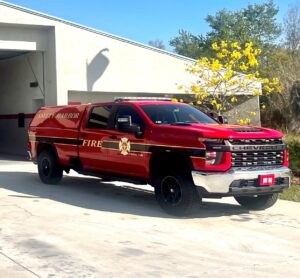 By Josh M. Stefancic, Fire Chief, City of Safety Harbor Fire Department and Andrew Portale, Firefighter/Paramedic, City of Safety Harbor Fire Department
By Josh M. Stefancic, Fire Chief, City of Safety Harbor Fire Department and Andrew Portale, Firefighter/Paramedic, City of Safety Harbor Fire Department
In early December 2021, in collaboration with Pinellas County Safety & Emergency Services, the City of Safety Harbor’s fire department placed a new quick response vehicle into service to assist in managing increased demand on emergency medical services in the community. The advanced life support (ALS) capable vehicle is staffed episodically with at least one licensed firefighter/paramedic and one licensed firefighter/EMT. The unit, when available, supplements the county’s existing ALS foundational units to increase unit availability for critical calls, reduce wear and tear on heavy apparatus, and utilize staff more effectively.
The Safety Harbor Fire Department’s daily staffing model expands, and contracts based on firefighter’s use of vacation, sick, or other leave types. The organization has a minimum staffing policy, and like other departments, must backfill with overtime when staffing drops below minimum thresholds to ensure at least one ALS unit is available at each fire station. However, when maximum staffing is achieved (all firefighters present), the department can staff its quick response vehicle at no additional personnel cost utilizing already on-duty personnel. Prior to utilizing the quick response vehicle concept, surplus staff members would be assigned to existing fire station units.
Since program inception, the community has seen an improvement in EMS response. During the month of January 2022, the quick response vehicle was available for 181 hours; 11 total instances ranging from 8-24 hours. For the month of January in 2019, 2020, and 2021, the area experienced established response time compliance 73% of the time, on average; in January 2022, the area experienced compliance 95% of the time. The quick response vehicle is supporting the EMS system by adding system redundancy and responding to medical incidents of all types, and has at least one documented “save” of a resident who unexpectedly went into cardiac arrest.
Another benefit of establishing the quick response vehicle program includes less wear and tear on heavy department apparatus such as fire engines and fire trucks. Historical data indicates department apparatus are responding to approximately six calls per day; calls range from EMS incidents, traffic incidents, fire alarms and structure fires. The regularly irregular use of such large equipment like a fire truck places increased demands on municipal maintenance budgets, and shorter replacement programs which stress capital improvement plans. It is hoped that the use of a quick response vehicle will increase longevity of department fire engines and fire trucks, as well as decrease the need for unbudgeted emergency repairs. Furthermore, the department’s gasoline-fueled quick response vehicle is considerably lighter in weight than the City’s diesel-fueled fire engines and trucks.
Going forward, the city will continue to monitor the impact the quick response unit has on the community. Data, such as availability rates, response times, fuel costs, engine hours, and personnel costs, will continue to be evaluated to ensure continuous improvement to the city and county. The establishment of a quick response unit in the City of Safety Harbor was a combined effort between multiple stakeholders including the fire department, public works department, the local bargaining unit, and as previously stated, Pinellas County. Such discussions on the concept of the unit began almost two years prior to implementation and it was ensured that the implementation and maintenance of the vehicle would only be completed if it was best for the community. Though this concept is not new to the fire service or EMS industry, it is new to the City of Safety Harbor and one that has increased efficiency and effectiveness for the area.





